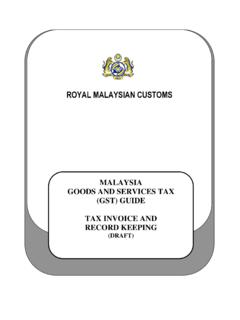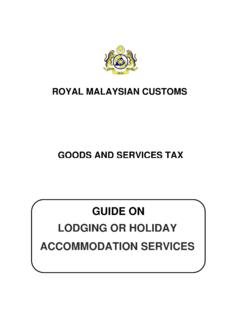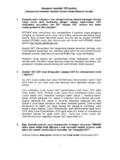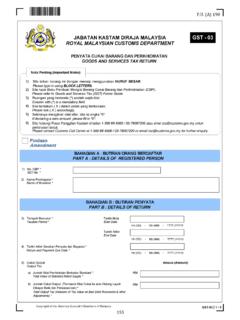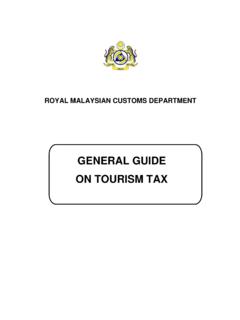Transcription of GUIDE ACCOUNTING SOFTWARE ENHANCEMENT …
1 ROYAL MALAYSIAN CUSTOMS GOODS AND SERVICES TAX GUIDE ON ACCOUNTING SOFTWARE ENHANCEMENT TOWARDS GST COMPLIANCE Publication Date Published: 05 February 2018. The GUIDE on ACCOUNTING SOFTWARE ENHANCEMENT towards GST Compliance revised as at 2 March 2017 is withdrawn and replaced by the GUIDE on ACCOUNTING SOFTWARE ENHANCEMENT towards GST Compliance revised as at 05 February 2018. Copyright Notice Copyright 2016 Royal Malaysian Customs Department. All rights reserved. Subject to the Copyright Act, 1987 (Malaysia). The GUIDE may be withdrawn, either wholly or in part, by publication of a new GUIDE . No part of this publication may be reproduced, stored in a retrieval system or transmitted in any form, including on-site for commercial purposes without written permission from the Royal Malaysian Customs Department (RMCD). In reproducing or quoting the contents, acknowledgment of source is required. Disclaimer This information is intended to provide a general understanding of the relevant treatment under Goods and Services Tax and aims to provide a better general understanding of taxpayers tax obligations.
2 It is not intended to comprehensively address all possible tax issues that may arise. While RMCD has taken the initiative to ensure that all information contained in this GUIDE is correct, the RMCD will not be responsible for any mistakes and inaccuracies that may be contained, or any financial loss or other incurred by individuals using the information from this GUIDE . All information is current at the time of preparation and is subject to change when necessary. i GUIDE ON ACCOUNTING SOFTWARE ENHANCEMENT TOWARDS GST COMPLIANCE As at 5 FEBRUARY 2018 CONTENTS INTRODUCTION .. 1 IMPORTANCE OF ACCOUNTING SOFTWARE FOR BUSINESSES .. 4 GUIDANCE FOR SOFTWARE DEVELOPERS .. 5 General Principles of ACCOUNTING SOFTWARE .. 5 GST SPECIFIC ISSUES ON ACCOUNTING SOFTWARE .. 10 Purchase Listing .. 11 Supply Listings .. 11 Foreign Currency Transactions .. 12 Mixed Supplier/ Partially Exempt Traders .. 12 KEEPING OF RECORDS .. 13 CONCLUSION.
3 14 FREQUENTLY ASKED QUESTIONS .. 15 INQUIRY .. 24 FURTHER ASSISTANCE AND INFORMATION ON GST .. 24 APPENDIX 1 .. 25 Key Data Elements Commonly Held In ACCOUNTING SOFTWARE .. 25 APPENDIX 2 .. 33 Data Required for GST Filing .. 33 APPENDIX 3 .. 34 Recommended GST Tax Code Listings for Purchase and Supply .. 34 APPENDIX 4 .. 46 Mapping of GST Tax Codes with GST-03 Return .. 46 APPENDIX 5 .. 49 GUIDE on Partial Exemption Module for ACCOUNTING SOFTWARE .. 49 APPENDIX 6 .. 61 File Format Definition for Taxpayer Access Point (TAP) File .. 61 APPENDIX 7 .. 66 File Format Definition for GST Audit File (GAF) .. 66 AMENDMENTS .. 101 4 GUIDE ON ACCOUNTING SOFTWARE ENHANCEMENT TOWARDS GST COMPLIANCE As at 5 FEBRUARY 2018 INTRODUCTION 1. This GUIDE provides guidance to ACCOUNTING SOFTWARE developers on the functionalities that should be setup for developing or enhancing their ACCOUNTING SOFTWARE towards Goods & Services Tax (GST) compliance.
4 SOFTWARE developers are advised to comply with the recommendations in this GUIDE . For example, the ACCOUNTING SOFTWARE is recommended to be capable for generating a standard file known as Taxpayer Access Point (TAP) File and GST Audit File (GAF). 2. This GUIDE also provides guidance to GST registrant that used any ACCOUNTING SOFTWARE for their businesses. All the information and recommendation as prescribed in this GUIDE such as tax code for purchase & supply, mapping of GST tax codes with GST- 03 return, and GST reports in form of GAF will ensure better GST compliance for businesses. 3. Although the content in this GUIDE are generally published from a GST perspective, the SOFTWARE requirements still align with existing best practices for businesses in Malaysia. IMPORTANCE OF ACCOUNTING SOFTWARE FOR BUSINESSES 4. By referring GST legislations, proper record keeping is essential for precise GST declarations.
5 Generally, ACCOUNTING SOFTWARE can generates many operational and financial information that are useful for efficient businesses management & operation. This will ease businesses to produce any ACCOUNTING information for GST reporting purposes. 5. The usage of an ACCOUNTING SOFTWARE is to make sure the accuracy of the business record and less likely to make errors in their tax declarations. This would reduce compliance costs for businesses, as any tax reporting errors would result in additional cost and penalties being imposed. Other than that, this GUIDE contain standard format of Taxpayer Access Point (TAP) file. This TAP file is an alternative method to the taxpayers for submitting information into GST-03 return. This is because the information needed in completing a GST-03 return is directly generated from their ACCOUNTING SOFTWARE . 6. Royal Malaysian Customs Department (RMCD) will audit businesses from time to time to ensure that businesses are making correct tax declarations.
6 It is a common 5 GUIDE ON ACCOUNTING SOFTWARE ENHANCEMENT TOWARDS GST COMPLIANCE As at 5 FEBRUARY 2018 procedure for RMCD to request for certain ACCOUNTING information as part of the auditing process. For businesses that are using manual records keeping, the process of producing the records required for the auditors is usually time-consuming. Businesses that use ACCOUNTING SOFTWARE which is able to generate the GAF that recommended in this GUIDE would find it is easier to meet RMCD requests and this will save their time and effort. GUIDANCE FOR SOFTWARE DEVELOPERS 7. ACCOUNTING SOFTWARE is a set of ACCOUNTING procedures, internal mechanisms of control, books of account, plan and chart of accounts that are used for administering, recording, and reporting on financial transactions. An ACCOUNTING SOFTWARE can contains functional modules based on a common businesses requirements such as comprehensive internal controls, accounts receivable (AR), accounts payable (AP), sales order, purchase order, inventory, billing, general ledger, and several GST related transactions.
7 Therefore, the ACCOUNTING SOFTWARE must ensure that the user is comply with Malaysia GST requirements such as an efficient record keeping, and a correct declaration for GST-03 return. General Principles of ACCOUNTING SOFTWARE 8. SOFTWARE developers are required to ensure their ACCOUNTING SOFTWARE : (A) Provides the issuance of tax invoice, credit note/ debit note, self-billed invoice, and other related documents that comply with GST legislation; The ACCOUNTING SOFTWARE should be able to produce tax invoices as well as credit/ debit notes, and other related documents as prescribed below: (I) Tax Invoice Tax invoice is an important document for GST transactions. If invoice issued by the supplier does not comply with the GST legislations, the buyer will not be eligible for Input Tax Credit (ITC) claim. Therefore, SOFTWARE developer must ensure their system is able to comply with the GST legislations. Therefore, the tax invoice must fulfill the prescribed particulars based on GST legislations.
8 6 GUIDE ON ACCOUNTING SOFTWARE ENHANCEMENT TOWARDS GST COMPLIANCE As at 5 FEBRUARY 2018 (II) Credit Note/ Debit Note A person made or received a supply shall issue a credit note or debit note where, after the return for the supply has been furnished to the Director General, there is a change in the consideration for the supply in term of quantity, amount, tax rate or cancellation of transactions due to any adjustment in the course of business. (III) Self-billed Any recipient approved by the Director General is allowed to issue self-billed invoices in respect of the supplier s supplies for a period of approval effective date or period of the contracts between the recipient and the supplier. (IV) Other related documents Other related document such as document issued by auctioneer or a person selling the goods also must fulfill the prescribed particulars based on GST legislations. For further details on the requirements of tax invoice, credit note or debit note, self-billed invoices, document issued by auctioneer, please refer to GUIDE on Tax Invoice and Record Keeping.
9 (B) Provides a reporting facility for the generation of information necessary to prepare tax returns; The ACCOUNTING SOFTWARE shall ease users to obtain the necessary information required for periodic filing of GST tax returns (GST-03). For example, the ACCOUNTING SOFTWARE should be able to generate report containing all the data elements required for the GST electronic submission. (Please refer Appendix 6 for the data elements required for GST-03 submission via TAP). (C) Provides comprehensive documentation to assist auditors and users to understand how the system operates; The ACCOUNTING SOFTWARE shall has proper documentation that allow its users 7 GUIDE ON ACCOUNTING SOFTWARE ENHANCEMENT TOWARDS GST COMPLIANCE As at 5 FEBRUARY 2018 and auditors to operate and understand the ACCOUNTING SOFTWARE easily. This is including the delivery of such documentation can included printed manuals, system-based help files and online helps.
10 (D) Incorporates adequate internal controls to ensure reliability of the data being processed; SOFTWARE developers are required to ensure that internal controls within the ACCOUNTING SOFTWARE are able to perform preventive, restorative and corrective functions. In other words, it is able to detect errors and prevent reversal of errors that have been processed in the system. Internal controls in ACCOUNTING SOFTWARE that are relevant to the integrity of a GST declaration includes:- System Access Access controls to ensure that only authorized users can access, and the authorized users are according to authorized level. The access data also shall according to the permissions given. Password control specification shall include into the ACCOUNTING SOFTWARE . For example is password integrity such as minimum password length, password complexity, password history, etc. Backup Procedures Backup controls to guarantee retention of back-up copies of electronic records, computer programs, system documentation and recovery of electronic records in case of system failure.
